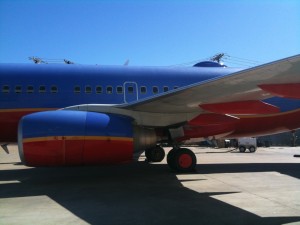Leeham News and Analysis
There's more to real news than a news release.
Odds and Ends: Korean tanker competition sounds like US rerun; About that blister on the top of airliners; JetBlue explains bags, seats
Korean tanker competition: South Korean is holding a competition for an aerial refueling tanker and in many respects, it sounds like a rerun of the USAF competition between Airbus and Boeing.
In the US contest, major debates happened over Bigger vs Smaller between the A330-200-based KC-330 MRTT and the 767-200ER-based Boeing tanker, which ultimately won and which was named the KC-46A.
This article neatly sums of this same issue in the Korean competition. It’s a matter of greater range, more fueling capacity, vs “enough” and better airport access; and global compatibility.
About that blister: Have you ever noticed the big “blister” in the top of airliner

The “blister” on top of the fuselage contains internet connectivity antennae. The power line appearing to come out of the top of the blister is not part of this. Source: AirlineReporter.com
fuselages? This is for Internet connectivity, an increasingly popular feature on airlines as passengers bring their own Nookbooks, iPads and the like to watch movies or cruise the Net. But aircraft lessors apparently don’t find these features all that desirable and are increasingly talking about having airlines take them out at the end of lease terms. Mary Kirby of Runway Girl Network has this story on the esoteric topic.
JetBlue explains bags, seats: JetBlue is reducing seat pitch and adding bag fees. CFO Mark Powers explains these moves in a Bloomberg News interview.
Little progress on A330 production gap
Subscription required.
Introduction
 With the end of the year a mere five weeks away, Airbus appears to have made little progress in closing its production gap for the A330.
With the end of the year a mere five weeks away, Airbus appears to have made little progress in closing its production gap for the A330.
Summary
- Airbus still has a gap of approaching 150 production slots at current and announced rates between now and the planned EIS of the A330neo in December 2017.
- Launch of A330neo helps, but does not cure production gap–especially between now and 2018.
- No Chinese order for A330 Regional after more than a year.
- AirAsiaX deferring orders–and will some CEO orders be swapped for the NEO?
Odds and Ends: No Boeing response to A321neoLR; After DL loss, Boeing wins Kuwait; It’s ‘huge’
No response to A321neoLR: Reuters reports that Boeing isn’t going to respond to the Airbus A321neoLR, the airplane intended to be a bonafide replacement for the Boeing 757.
“We are very happy with where the MAX 9 sits and feel the competition is simply doing things to catch up with it,” Randy Tinseth, vice president of marketing at Boeing Commercial Airplanes said, Reuters reports.
There’s really no other choice but to say Boeing is happy. As we demonstrated in our three-part 757 replacement series in October, the 737-9 can’t be made competitive with the A321neoLR. As Tinseth notes in the Reuters article, and which we covered in our three-part series, Boeing could put another fuel tank (as does Airbus in the A321neo) in the -9 to match the range. But what Tinseth did not note in Reuters (or at least it wasn’t reported if he did), and which we did write, the 737-9 comes up more than 15 passengers short of the A321neoLR and 20 passengers short of the 757–and it needs 12,000 ft of runway to take off with a full load.
Odds and Ends: JetBlue defers A320s; Delta’s A350 order; Another KC-46A delay?
JetBlue defers A320s: This US airline announced at its investors’ day that it is deferring Airbus A320s from this decade into next. JP Morgan had this commentary November 19:
JetBlue…announced a deferral of 18 A320-family aircraft from 2016-18 to 2022-23. While having a $900m positive impact on cap-ex through 2018, we believe the deferral should also limit near-term speculation on widebodies and Transatlantic expansion for several years. The reason? We believe the deferral was driven in large part by Airbus’ continued study of an ‘A321neoLR….’ Airbus continues to explore the development of a long-range version (3,900 nm) of its flagship narrowbody aircraft to serve as a fuel-efficient competitor to the Boeing 757-200W, with potential entry in to service by 2018-19. We believe such an aircraft would fit exceptionally well into JBLU’s longer-term expansion plans, though it does imply a Transatlantic future somewhere down the road, in our view.
JetBlue has expressed interest in entering long-haul, over-water routes, but it doesn’t have ETOPS qualification. If it were to do so sooner than later, it would have to either wetlease aircraft (as did WestJet of Canada) or lease the four-engine A340-300, a cheap lift with a modest capacity.
Lufthansa to use A340s in “lower cost” operation; our analysis against the 787
Subscription required.
By Scott Hamilton and Bjorn Fehrm
Introduction
Low cost long haul service is gaining traction, but previous efforts proved difficult to be successful.
Dating all the way back to Laker Airways’ Skytrain and the original PeoplExpress across the Atlantic, airlines found it challenging to make money.
More recently, AirAsiaX retracted some of its long-haul service, withdrawing Airbus A340-300 aircraft when they proved too costly. The airline recast its model around Airbus A330-300s as an interim measure, unable to fly the same distances as the longer-legged A340. AirAsiaX ordered the Airbus A350-900 and now is a launch customer for the A330-900neo.
 Cebu Pacific of the Philippines is flying LCC A330-300 service to the Middle East. Norwegian Air Shuttle famously built its entire LCC long haul model around the Boeing 787, initiating service with the 787-8 and planning to move to the 787-9.
Cebu Pacific of the Philippines is flying LCC A330-300 service to the Middle East. Norwegian Air Shuttle famously built its entire LCC long haul model around the Boeing 787, initiating service with the 787-8 and planning to move to the 787-9.
Canada’s WestJet is leasing in four used Boeing 767-300ERs to offer LCC service,
Legacy carrier Lufthansa Airlines plans to use fully depreciated A340-300s to begin “lower cost” (as opposed to “low cost”) long haul service. LH says the fully depreciated A340s come within 1%-2% of the cost per available seat mile of the new, high capital-cost 787s.
Summary
- AirAsiaX’s A340 LCC long haul service proved unprofitable. Can Lufthansa’s similar service with fully depreciated A340s work?
- Our analysis shows that it can. It can even support the lease rates that would be charged for a 10 year old A340 if the fuel price remains at the present level.
- When doing the research for this article and going through the results of our proprietary model we started to ask ourselves, is the A340-300 the ugly duckling of the airline market?
Airbus wins Delta wide-body order
Airbus has won the hotly-contested competition for 50 wide-body airplanes, two sources tell Leeham News and Comment.

Artist rendering of Delta Air Lines A350, via Twitter, original source unknown.
Airbus will sell Delta 25 A350-900s and 25 A330-900s, our sources say. Rolls-Royce is the sole-source engine supplier.
 Boeing hoped to sell Delta the 787-9 and also offered five new 777-200LRs as bridge lift until delivery slots for the 789 were available, according to our information.
Boeing hoped to sell Delta the 787-9 and also offered five new 777-200LRs as bridge lift until delivery slots for the 789 were available, according to our information.
Delta looks to double Seattle gates as wide-body decision nears
Delta Air Lines wants to double the number of its gates at Seattle, potentially allowing more than 300 flights a day, Bloomberg News reports. The story appeared just weeks before Delta will make its decision whether to order 50 wide-body jets from Airbus or Boeing, with about half of them planned for trans-Pacific service from Seattle and Delta’s Detroit hub; and the other half for trans-Atlantic service from New York and Atlanta.
Best-and-final-offers from Airbus and Boeing were due last week or this week and an internal decision is due after Thanksgiving, we are told. Delta is expected to announce its decision at its annual investors day, which is December 11 this year.
Airbus has its annual investors days December 10-11 in London. We don’t ascribe any significance to the concurrent dates, since these are dates of long-standing in years past.
Boeing fails to assure on 777 production gap
Subscription required
Introduction
Boeing’s ability—or inability—to bridge the production gap for the 777 Classic to the 777X entry-into-service in 2020 was a top concern of a series of Wall Street types during a recent series of meetings we had across the USA.
.
There is a great deal of skepticism over whether Boeing can successfully maintain the current production rate of 100/yr (8.3/mo). People we talked with look at the number of orders Boeing needs to bridge the gap, the Boeing claims that it can obtain 40-50 or 40-60 a year, and, in a more recent development, the falling oil prices depressing the need for a new, more efficient 777-300ER compared with the 2004 model and the even older 777-200ER series.
.
We have been telling our clients since March that Boeing will have to reduce the production rate of the 777 because of the large production gap. Aerospace analysts began waking up to this possibility by May and the broad consensus today is that Boeing will have to reduce the rate—the only questions remaining is by how much and how soon.
.
As recently as the 3Q2014 earnings call, Boeing continues to assert it will be able to maintain rates with new sales. Boeing has booked 43 firm orders through October for the 777 Classic—39 for the 300ER and four for the freighter. This is as the low-end of the range Boeing says it needs.
.
However, our Market Intelligences gathered over the summer and into the fall indicates sales efforts are struggling.
.
Summary
- Boeing clearly hasn’t been persuasive in its claims it will bridge the production gap at current rates;
- Boeing has open delivery slots in the second half of 2016;
- The big drop off in backlog begins in 2017 and gets worse going forward;
- Key airlines that have been pitched have said “no;”
- Emirates sends the industry’s first operational 777-300ER to scrap;
- Bow wave of 777s coming to 12 years and off lease begins soon, creating cheap alternatives to new sales; and
- Lessors will be compelled to offer -300ERs for low prices, depressing opportunities for Boeing.


Fundamentals of airliner performance, Part 3
By Bjorn Fehrm
In our first article about how to understand the performance of a modern airliner we defined the main forces that are acting on an aircraft flying in steady state cruise. In our clinic we use the ubiquitous Boeing 737 in its latest form, the 737 MAX 8, to illustrate our case. In the second article we introduced the aircraft’s engines and understood how they function by pumping air backwards faster than the aircraft’s speed and therefore generating thrust as air is in fact quite heavy. We also looked at the influence of flight altitude on the performance of the aircraft.
In the second article we introduced the aircraft’s engines and understood how they function by pumping air backwards faster than the aircraft’s speed and therefore generating thrust as air is in fact quite heavy. We also looked at the influence of flight altitude on the performance of the aircraft.
In short we can conclude our findings so far:
Having covered the most important aspects of cruise we will today look at takeoff, a subject with a lot of aspects. Read more
Leave a Comment
Posted on November 19, 2014 by Bjorn Fehrm
Boeing, CFM, Leeham News and Comment, Uncategorized
737 MAX, Boeing, CFM, CFM Leap-1B